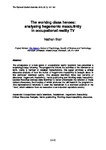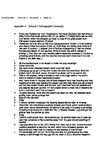The working class heroes: analysing hegemonic masculinity in occupational reality TV
| dc.contributor.author | Blair, N. | |
| dc.date.accessioned | 2019-05-15T15:21:42Z | |
| dc.date.available | 2019-05-15T15:21:42Z | |
| dc.date.issued | 2013 | |
| dc.identifier.citation |
Blair, N. (2013) 'The working class heroes: analysing hegemonic masculinity in occupational reality TV', The Plymouth Student Scientist, 6(1), p. 137-160. | en_US |
| dc.identifier.issn | 1754-2383 | |
| dc.identifier.uri | http://hdl.handle.net/10026.1/14013 | |
| dc.description.abstract |
The emergence of a new genre of occupational reality television has generated a surprisingly large following. The programme follows the activities of the trawlermen at work. Using a number of detailed transcriptions, this paper provides a critical discourse analysis of how the notion of hegemonic masculinity is brought about in this particular television genre. The analysis identified three key patterns of discourse: Hegemonic Masculinity, Heroic positioning and Working-class masculinity. Several rhetorical devices were identified to better understand the function of these various discourses, the interplay of which produces the talk heard in the programme. This representation functions to exalt the trawlermen to a dominant position of the ‘Hero’, which validates them as masculine in an industrial capitalistic society. | en_US |
| dc.language.iso | en | en_US |
| dc.publisher | University of Plymouth | |
| dc.rights | Attribution 3.0 United States | * |
| dc.rights.uri | http://creativecommons.org/licenses/by/3.0/us/ | * |
| dc.subject | occupational reality television | en_US |
| dc.subject | trawlermen at work | en_US |
| dc.subject | hegemonic masculinity | en_US |
| dc.subject | Heroic positioning | en_US |
| dc.subject | Working-class masculinity | en_US |
| dc.title | The working class heroes: analysing hegemonic masculinity in occupational reality TV | en_US |
| dc.type | Article | |
| plymouth.issue | 1 | |
| plymouth.volume | 6 | |
| plymouth.journal | The Plymouth Student Scientist |




